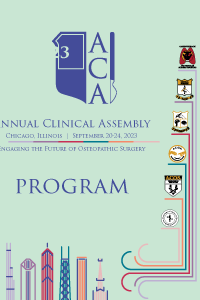General Surgery
Ultrashort-segment Hirschsprung’s disease complicated by megarectum and obstructive uropathy: A case report
Location: Grandball Room 1-2
- WG
Wyatt R. Glasgow, MS IV
Campbell University School of Osteopathic Medicine
Salisbury, Maryland, United States
Primary Presenter(s)
Introduction/Purpose: Ultrashort-Segment Hirschsprung Disease (USHD) is:
• Rare variant of HD defined as an aganglionic rectal segment >1-2 cm in distal rectum or colon.
• Accounts for < 3% of all cases of HD
• HD discovered in adults accounts for < 1%
• Typically young men (average age 30)
Characterized by:
• Chronic, refractory constipation
• Abdominal distention
• Colicky pain +/- acute intestinal obstruction
Is associated with:
• Down syndrome: in ~10% of HD
• MEN IIa
• Neuroblastoma
• Wardenburg-Shah Syndrome
Complications:
• Hirschsprung-associated enterocolitis (HAEC)
• Overall mortality of HAEC is 3-12%3.
• Occurs in nearly 16% of patients and contributes to 50% of mortalities3 seen in HD.
Methods or Case Description: 33 year old male with history of chronic constipation refractory to laxatives. No history of abdominal surgery or medication use.
Initial presentation: Severe abdominal pain, distention,, vomiting and no bowel movement for the last 10 days. Decreased urine output and stool in urine. Cramping pain (10/10), intermittent, and non-radiating. Abdomen is firm, grossly distended, and tender.
Outcomes: Surgical Pathology:
Interestingly, Histologic examinations were conducted on biopsies taken every 10 cm showed submucosal and myenteric ganglion cells in all sections.
Conclusion: The term USHD, which traditionally refers to clinical manifestations resembling classic Hirschsprung's disease (often seen in adults ) has been a subject of ongoing debate regarding its validity, with differing opinions on its prevalence1,2 and best treatment methods 4,6. Currently, USHD is diagnosed when a documented aganglionic rectal segment measures less than 1-2 cm. In the case of this patient, declining hemodynamic status necessitated urgent exploratory laparotomy which prevented prior biopsy. Histologic examination of section biopsies taken every 10 cm showed ganglion cells in all sections; however, due to diagnostic criteria of 1-2 cm and nature of disease, the presence of ganglion cells in these samples does not definitively exclude the diagnosis due to sampling error and missed diagnosis. Given all evidence, we believe that this case is highly indicative of USHD. While we believe that clinically this diagnosis is most likely, USHD is among multiple “Variants of Hirschsprung Disease”- conditions that clinically indistinguishable from HD, despite the presence of ganglion cells in rectal suction biopsies. These may include:
• Rare variant of HD defined as an aganglionic rectal segment >1-2 cm in distal rectum or colon.
• Accounts for < 3% of all cases of HD
• HD discovered in adults accounts for < 1%
• Typically young men (average age 30)
Characterized by:
• Chronic, refractory constipation
• Abdominal distention
• Colicky pain +/- acute intestinal obstruction
Is associated with:
• Down syndrome: in ~10% of HD
• MEN IIa
• Neuroblastoma
• Wardenburg-Shah Syndrome
Complications:
• Hirschsprung-associated enterocolitis (HAEC)
• Overall mortality of HAEC is 3-12%3.
• Occurs in nearly 16% of patients and contributes to 50% of mortalities3 seen in HD.
Methods or Case Description: 33 year old male with history of chronic constipation refractory to laxatives. No history of abdominal surgery or medication use.
Initial presentation: Severe abdominal pain, distention,, vomiting and no bowel movement for the last 10 days. Decreased urine output and stool in urine. Cramping pain (10/10), intermittent, and non-radiating. Abdomen is firm, grossly distended, and tender.
- Relevant labs: WBC’s 29.1 with neutrophilic predominance, CMP Na-135, BUN 14, creatinine 0.50 with glucose 174. Lactic acid unremarkable 1.5, lipase unremarkable 23.
- CT scan of Abdomen/Pelvis with IV contrast: Massive stool in rectum, sigmoid colon, and L colon w/ dilatation. Redundant sigmoid colon.Bladder displaced anteriorly by rectum. Mass effect on the left ureter with L hydronephrosis. No free intra-abdominal fluid, free air or perforation.
- Emergency Surgery: The patient underwent emergency ex-lap with segmental resection of mid to distal transverse colon, left colon, sigmoid colon, and proximal rectum, and creation of Hartman's colostomy. Manual fecal disimpaction of the rectum ( >12 cm) was also performed.
- Postoperative Course: Patient developed respiratory failure secondary to slow clearance of anesthesia, and remained on mechanical ventilation for 36 hours but was extubated without complications. UTI was treated.
Outcomes: Surgical Pathology:
- 110 cm in length.
- 9.2 cm Proximally
- 16 cm distally at sigmoid/rectum
- 5.5 cm of pericolonic adipose tissue.
- Bowel wall slightly thickened and rubbery at the distal end, thickness of 0.6 cm.
- No evidence of mucosal-based masses.
Interestingly, Histologic examinations were conducted on biopsies taken every 10 cm showed submucosal and myenteric ganglion cells in all sections.
Conclusion: The term USHD, which traditionally refers to clinical manifestations resembling classic Hirschsprung's disease (often seen in adults ) has been a subject of ongoing debate regarding its validity, with differing opinions on its prevalence1,2 and best treatment methods 4,6. Currently, USHD is diagnosed when a documented aganglionic rectal segment measures less than 1-2 cm. In the case of this patient, declining hemodynamic status necessitated urgent exploratory laparotomy which prevented prior biopsy. Histologic examination of section biopsies taken every 10 cm showed ganglion cells in all sections; however, due to diagnostic criteria of 1-2 cm and nature of disease, the presence of ganglion cells in these samples does not definitively exclude the diagnosis due to sampling error and missed diagnosis. Given all evidence, we believe that this case is highly indicative of USHD. While we believe that clinically this diagnosis is most likely, USHD is among multiple “Variants of Hirschsprung Disease”- conditions that clinically indistinguishable from HD, despite the presence of ganglion cells in rectal suction biopsies. These may include:
- Immature ganglia
- Intestinal ganglioneuromatosis
- Internal anal sphincter achalasia
- Congenital smooth muscle cell disorders such as megacystis microcolon intestinal hypoperistalsis syndrome
- Intestinal neuronal dysplasia
- Absence of the argyrophil plexus
- Isolated hypoganglionosis.

